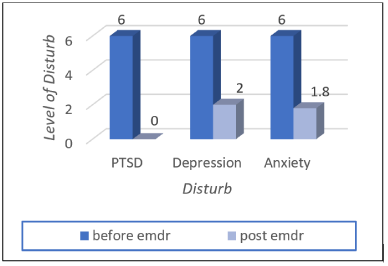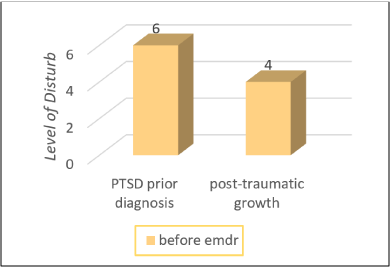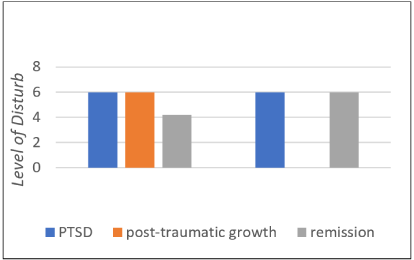
Research Article
Austin J Cancer Clin Res. 2021; 8(1): 1088.
Eye Movement Desensitization and Reprocessing Treatment in Oncological Patients. Preliminary Research Project
Bonucci M1,2*, Colistro MCU3 and Fiorentini C1
1ARTOI (Association Research Integrative Oncology Therapies), Italy
2Department of Integrative Oncology, Nuova Villa Claudia Hospital, Italy
3Association EMDR EU, Italy
*Corresponding author: Max Bonucci, Chief of Integrative Oncology Department. Nuova Villa Claudia Hospital, Rome, Italy
Received: February 26, 2021; Accepted: March 19, 2021; Published: March 26, 2021
Abstract
Patients with Cancer (C) have an important risk of developing Post Traumatic Stress Disorder (PTSD), but few studies have assessed the efficiency of psychological interventions to treat it. Also, it is known that the presence of unprocessed traumatic experiences prior to diagnosis, represents a risk of the onset of a PTSD. Furthermore, no studies have analyzed the quality of such traumatic experiences during C patients life. The study has the threefold objective of assessing the effectiveness of Eye Movement Desensitization and Reprocessing therapy (EMDR) in C patients diagnosed with PTSD, examining the presence of unprocessed traumatic experiences in the pre-diagnosis lives of C patients and analyzing these clinical experience in relation to the localization of the primary cancer. Patients with C diagnosis at any stage of the disease were included, receiving either EMDR. Patients were assessed before and after (follow-up) treatments with clinical questionnaires. Patients at the first diagnosis undergo 10 sessions of psychotherapy, while patients with recurrence are subjected to 16 sessions. We had 3 patients, 2 at second stage of disease (just before to start therapy) and 1 at his third recurrence. Localization of primary cancer: Shoulder, breast, skin. Results show complete remission of PTSD in all patients, the presence of unprocessed traumatic experiences in the pre-diagnosis lives (mourning). Confirming the efficiency of EMDR in PTSD in C patients, would mean being able to rely on a powerful psychological tool in an area where the emotional aspect plays a key role in recovery patients’ psychophysical and quality of life. It is also impressive to assess the relationship between the presence of raw traumatic events prior to the communication of the diagnosis and onset of PTSD, as well as the nature of these experiences. These clinical data are essential both to plan increasingly detailed and specific treatments in terms of quality and time, and to think of a psychological prevention perspective dedicated to the person understood as a totality.
Keywords: EMDR; Cancer patient; Psychological intervention; Traumatic stress; Unprocessed traumatic experienceer
Introduction
Post Traumatic Stress Disorder (PTSD) is a condition caused by severe stress or subsequent chronic distress, which is generally associated with a life-threatening experience [1]. PTSD causes mental and somatic diseases, possibly resulting in neuropsychological, cardiovascular, gastrointestinal, metabolic, endocrine, and oncological diseases. The PTSD-induced elevation of carbonylated proteins and lipid peroxidation products in brain, heart, liver reflects oxidative stress, a known cause of organ pathology [2,3]. If, on one side, a plethora of scientific researches have evidenced that receiving a diagnosis of cancer is an important risk factor for PTSD [4,5], on the other side, most recent studies point at PTSD as a possible consequence as well as a cause of various organic pathologies [5-7] These findings directed our attention toward a deeper analysis of this psychological disorder. In fact, it is equally important to experiment possible therapies for the prevention and treatment of PTSD in the aftermath of the diagnosis of an oncological disease, and to analyse the possible relapses of PTSD or post-traumatic growth as a concause for the development of cancer pathology. Also, it may be interesting to verify the existence of a possible relationship between the presence of PTSD prior to cancer diagnosis and the localization of the disease itself [8-10].
Several scientific researches have shown that the current pharmacological treatment for PTSD is not adequately effective and may cause serious side effects [12]. Contrariwise, many studies describe the Eye Movement Desensitization and Reprocessing (EMDR) as a very efficient psychological treatment in the psychooncology area, proving that the EMDR was effective in significantly reducing symptoms of PTSD, anxiety, and depression, short timelimited, with large effect sizes in patients with cancer [13-16].
Therefore, we intend to direct this investigation on different research and analysis plans. In primis, we aim at verifying the effectiveness of EMDR treatment, both as a therapy and as a tool to prevent its onset, in a population of cancer patients regarding PTSD. Also, we intend to record the presence of PTSD, unprocessed traumatic events and post-traumatic growth, during the life period of the pre-diagnosis, and to analyze the relationship between them and the localization of cancer. Our hypothesis is that the chronicity of a toxic psychological condition may represent a concause for the development cancer and for its localization in the target organ [8-10].
Methods
Three patients with different types of cancer (localizations of primary cancer: shoulder, breast, skin), 2 at second stage of disease (just before to start therapy) and 1 at his third recurrence, were recruited at Nuova Villa Claudia Hospital from June to November 2019.
They all received EMDR. Patients were assessed before and after (follow-up) treatments with a clinical interview, to investigate the presence of unprocessed traumatic experiences before the onset of the disease and specific questionnaires to assess the presence of PTSD linked to cancer diagnosis. Patients at the first diagnosis undergo 10 sessions of psychotherapy while patients with recurrence are subjected to 16 sessions. All the 3 patients agreed to participate in the study.
Results
The results show the application of EMDR induced 100 % remission of PTSD in all patients, a complete reduction of anxiety and depression in 1/3 of patients and a significant reduction (70%), in the remaining 2/3 patients (Figure 1). Furthermore, in all the three patients examined, unprocessed traumatic experiences in the prediagnosis lives (mourning) were reported.

Figure 1: Results show an important decrease of PTSD, depression and
anxiety in the reference group after EMDR therapy.
All these patients, in the period of life that preceded the diagnosis of cancer, coped with raw traumatic experience or post-traumatic growth: 1/3 (skin) had 1 unprocessed traumatic event, 1/3 (breast) had 2 unprocessed traumatic event and 1 post-traumatic growth, 1/3 (shoulder, with 3 recurrences) had >10 unprocessed traumatic event and 1 post-traumatic growth (Figures 2,3).

Figure 2: Results show the presence of PTSD in the life period before cancer
in 100% of patients and post-traumatic growth in 2/3.

Figure 3: Results show that the presence of post-traumatic growth in the
life period before cancer may be related to a percentage of remission of the
psychological disorder after therapy.
Discussion
The preliminary results herein reported, although based on a limited sample, suggest the effectiveness of EMDR therapy in the treatment of the PTSD developed as a consequence of an oncological diagnosis. To confirm the efficiency of EMDR for PTSD in cancer patients would mean to rely on a powerful psychological tool in an area where the emotional aspect plays a key role in the recovery patients’ psychophysical and quality of life. Also, it would be important to assess the relationship between the presence of PTSD and post-traumatic growth prior to the communication of the diagnosis and onset of the cancer, as well as the nature of these experiences. Another important suggestion that emerges from this analysis concerns the presence of a post-traumatic growth in patients in whom the percentage of remission of anxious symptoms is lower than in patients who present only a PTSD before diagnosis.
These clinical data may pave the way both to plan increasingly detailed and specific treatments in terms of quality and time, and to think of a psychological prevention perspective dedicated to the person understood as a totality. If these collected data are confirmed by a subsequent more extensive investigation, that will mean that the presence of PTSD can negatively affect the course of the oncological disease. However, this could also imply the possibility of preventing, as well as treating, PTSD and his repercussion on heath and on the course of the oncological disease itself.
References
- Haerizadeh M, Sumner JA, Birk JL, Gonzalez C, Heyman-Kantor R, Falzon L, et al. Interventions for posttraumatic stress disorder symptoms induced by medical events: A systematic review. J Psychosom Res. 2020; 129: 109908.
- Manukhina EB, Tseilikman VE, Karpenko MN, Pestereva NS, Tseilikman OB, Komelkova MV, et al. Intermittent Hypoxic Conditioning Alleviates Post- Traumatic Stress Disorder-Induced Damage and Dysfunction of Rat Visceral Organs and Brain. Int J Mol Sci. 2020; 21: 345.
- Wright F, Kober KM, Cooper BA, Paul SM, Conley YP, Hammer M, et al. Higher levels of stress and different coping strategies are associated with greater morning and evening fatigue severity in oncology patients receiving chemotherapy. Support Care Cancer. 2020; 28: 4697-4706.
- Von Toorenburg MM, Sanches SA, Linders B, et al. Do emotion regulation difficulties affect outcome of intensive trauma-focused treatment of patients with severe PTSD? Eur J Psychotraumatol. 2020; 11: 1724417.
- Nipp RD, El-Jawahri A, D’Arpino SM, Chan A, Fuh C-X, Johnson PC, et al. Symptoms of posttraumatic stress disorder among hospitalized patients with cancer. Cancer. 2018; 124: 3445-3453.
- Borji M, Tarjoman A, Abdi A, Otaghi M. Efficacy of Implementing Home Care Using Eye Movement Desensitization and Reprocessing in Reducing Stress of Patients with Gastrointestinal Cancer. Asian Pac J Cancer Prev. 2019; 20: 1967-1971.
- Carletto S, Porcaro C, Settanta C, Vizzari V, Stanizzo MR, Oliva F, et al. Neurobiological features and response to eye movement desensitization and reprocessing treatment of posttraumatic stress disorder in patients with breast cancer. Eur J Psychotraumatol. 2019; 10: 1600832.
- de Voogd LD, Kanen JW, Neville DA, Roelofs K, Fernandez G, Hermans EJ. Eye-Movement Intervention Enhances Extinction via Amygdala Deactivation. J Neurosci. 2018; 38: 8694-8706.
- Cordova MJ, Riba MB, Spiegel D. Post-traumatic stress disorder and cancer. Lancet Psychiatry. 2017; 4: 330-338.
- Parikh D, De Ieso P, Garvey G, Thachil T, Ramamoorthi R, Penniment M, et al. Post-traumatic stress disorder and post-traumatic growth in breast cancer patients--a systematic review. Asian Pac J Cancer Prev. 2015; 16: 641-646.
- Osorio A, Perez M, Tirado G, Jarero I, Givaudan M. Randomized Controlled Trial on the EMDR Integrative Group Treatment Protocol for Ongoing Traumatic Stress with Adolescents and Young Adults Patients with Cancer. American Journal of Applied Psychology. 2018; 7: 50-56.
- Mavranezouli I, Megnin-Viggars O, Daly CH, Dias S, Welton NJ, Stockton S, et al. Psychological treatments for post-traumatic stress disorder in adults: a network meta-analysis. Psyches Med. 2020: 1-14.
- Chamberlin DE. The Predictive Processing Model of EMDR. Front Psychol. 2019; 10: 2267.
- Santarnecchi E, Bossini L, Vatti G, Fagiolini A, Porta PL, Lorenzo GD, et al. Psychological and Brain Connectivity Changes Following Trauma-Focused CBT and EMDR Treatment in Single-Episode PTSD Patients. Front Psychol. 2019; 10: 129.
- Capezzani L, Ostacoli L, Cavallo M, Carletto S, Fernandez I, Solomon R, et al. EMDR and CBT for cancer patients: Comparative study of effects on PTSD, anxiety, and depression. Journal of EMDR Practice and Research. 2013.
- Karatzias T, Power K, Brown K, McGoldrick T, Begum M, Young J, et al. A controlled comparison of the effectiveness and efficiency of two psychological therapies for posttraumatic stress disorder: Eye Movement Desensitization and Reprocessing vs. Emotional Freedom Techniques. J Nerv Ment Dis. 2011; 199: 372-378.